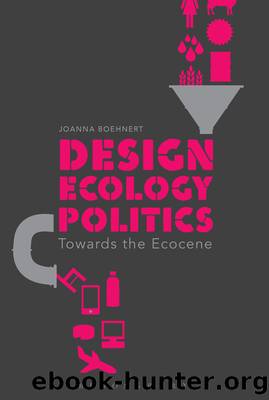Design, Ecology, Politics by Joanna Boehnert

Author:Joanna Boehnert
Language: eng
Format: epub
Publisher: Bloomsbury UK
9 Ecological Perception 1 – Theory
Communication designers have a pivotal role to play in the creation of sustainable futures due to their ability to support the development of new cognitive skills for dealing with complexity and new social capacities to act on the basis of new knowledge. Designers can make ecological processes and relationships visible, tangible and accessible. By drawing attention to relationships, they can nurture ecological ways seeing and knowing. Within the context of an increasingly visual culture, images can communicate complexity and encourage the noticing of ecological phenomenon. Graphic design is especially well suited to facilitate ecological learning as it can draw on a wide variety of visual strategies to display specific geographic spaces, ecological patterns and processes, and complex dynamic systems. Environmental communication scholar Julie Doyle maintains that photography records circumstances of the past, so its usefulness in communicating climate change is limited to displaying damages already done (2009). Graphic design, on the other hand, has greater potential to respond to environmental communication challenges due to its ability to visualize information in very specific ways (this includes visualizing abstract concepts, future scenarios, geographic spaces, comparative data sets, complex systems and more). Designers use maps, charts, diagrams, graphs, timelines, illustrations, network visualizations, data visualization and information graphics towards different ends. In the following two chapters, I describe how designers can support new ways of seeing by directing attention to relationships – and thereby encourage relational or ecological perception.1 The first chapter introduces the theory and the second the practice of ecological perception. To develop this concept, I review the ways in which perceptual practices have evolved over time with a brief history of communication theory and the emergence of 'visual intelligence'. I describe how visual metaphors function to challenge and potentially disrupt preconceived assumptions. Linking communication theory with ecological theory informs new strategies for revealing ecological relations. By displaying relationships, patterns and dynamics in complex systems, designers can support visual intelligence, relational perceptual practices and the ability to ‘see systems’.
History of Modes of Communication
Social theorists and historians describe changing modes of communication and media as having profound social consequences. Famously, Marshall McLuhan explained, ‘the effects of technology do not occur at the level of opinions or concepts, but alter sense ratios or patterns of perception steadily and without any resistance’ (2001 [1967], 290). The historical shift from oral to written cultures in the West (starting in Greece around the fifth century BC) shaped new ways of perceiving and thinking that emerged in this time period. Historian Walter Ong describes oral cultures as having very different perceptual practices than those that characterize written cultures: in oral culture knowledge is fixed, formulaic and mnemonic (1982, 24). Reading and writing, on the other hand, are dissecting processes that organize information in a linear sequence and establish a context-free mode of communication, thereby conditioning consciousness towards an alienation from context and place, Ong’s analysis of the seismic shifts that occurred during the historical oral–written communication revolution informs an understanding of an equally
Download
This site does not store any files on its server. We only index and link to content provided by other sites. Please contact the content providers to delete copyright contents if any and email us, we'll remove relevant links or contents immediately.
The Secret History by Donna Tartt(16623)
The Social Justice Warrior Handbook by Lisa De Pasquale(11489)
Thirteen Reasons Why by Jay Asher(7788)
This Is How You Lose Her by Junot Diaz(5772)
Weapons of Math Destruction by Cathy O'Neil(5037)
Zero to One by Peter Thiel(4824)
The Myth of the Strong Leader by Archie Brown(4789)
Promise Me, Dad by Joe Biden(4447)
Beartown by Fredrik Backman(4419)
Stone's Rules by Roger Stone(4415)
How Democracies Die by Steven Levitsky & Daniel Ziblatt(4399)
The Fire Next Time by James Baldwin(4343)
100 Deadly Skills by Clint Emerson(4078)
A Higher Loyalty: Truth, Lies, and Leadership by James Comey(4033)
Rise and Kill First by Ronen Bergman(4012)
The David Icke Guide to the Global Conspiracy (and how to end it) by David Icke(3882)
The Farm by Tom Rob Smith(3872)
Secrecy World by Jake Bernstein(3782)
The Doomsday Machine by Daniel Ellsberg(3731)
